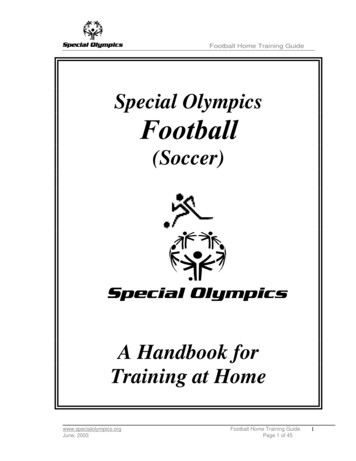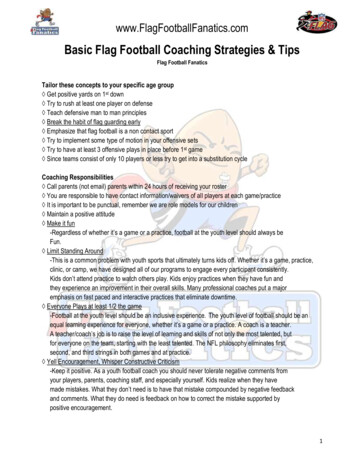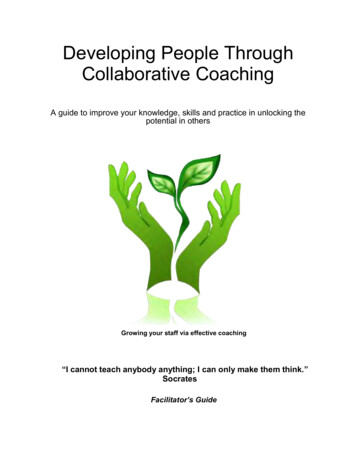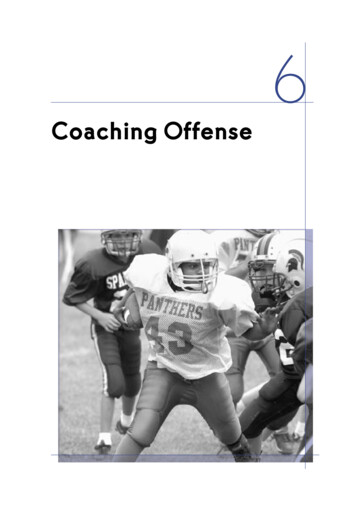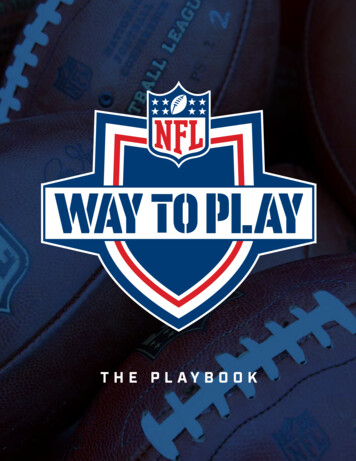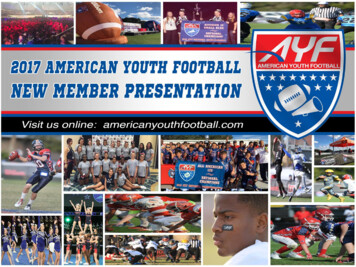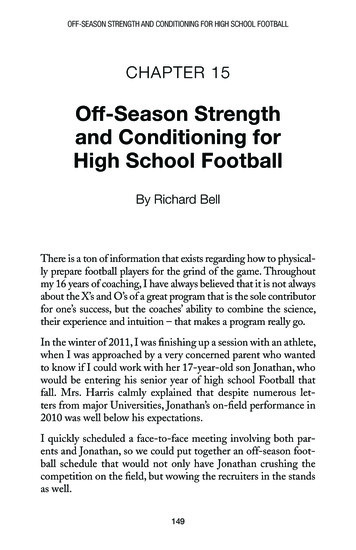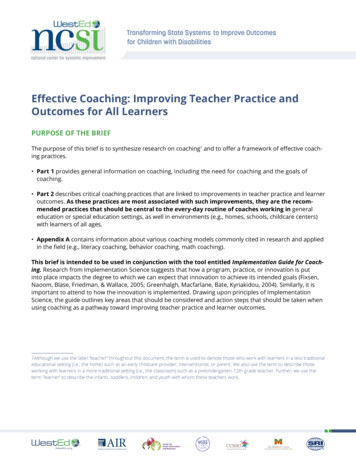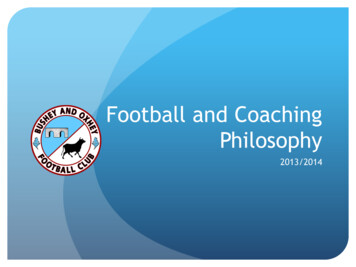
Transcription
Football and CoachingPhilosophy2013/2014
Introduction Safety of our children is our number 1 priority All Bushey & Oxhey FC coaches are CRB (Criminal Record Bureau) checkedhold a minimum of the FA Level 1 coaching qualificationthey have attended the FA’s Child Protection Coursehold the FA’s Emergency First Aid Certificateand are encouraged to join the FA Licenced Coaches Club In the pursuit of a high quality coaching environment, coachesare encouraged to go as far as possible through the FA’s coachingpathway Our clearly defined coaching philosophy provides direction,purpose and guidance to the process of coaching young players.
Coachingrecommendationsfor players aged5-11 yearsAGE GROUPS 12-16We promote aholistic approachbased upon theFA’s four-cornermodel for longterm playerdevelopmentAGE GROUPS 5-11Our clearlydefined coachingphilosophyprovides direction,purpose andguidance to theprocess ofcoaching youngplayersPLAYER DEVELOPMENTCOACHING PHILOSOPHYContentsCoachingrecommendationsfor players aged12-16 years
COACHING PHILOSOPHYFA Coaching Pathway
COACHING PHILOSOPHYCoaching Aims Make the game safe, fair and enjoyable Provide age-appropriate coaching (5-11,12-16, 17 ) Develop the whole player across all fourcorners of the Football Association’sLTPD model Develop the player’s technical skills Improve the player’s movement skills:agility, balance, co-ordination and speed(ABCs) Increase the player’s decision-makingcapabilities Teach the player life skills (co-operation,teamwork, communication and friendship)TECHNICALPHYSICALPSYCHOLOGICALSOCIAL
COACHING PHILOSOPHYRole of the Coach Mentor Listen to players, give advice and extend their thinking Motivator Set appropriate challenges to inspire the players Friend Make the environment welcoming and inclusive Facilitator Allow players to enjoy playing the game
COACHING PHILOSOPHYA good coach. Encourages players to try new skills Enthuses and motivates players Supports and inspires regular practice Encourages children to be the best that they can be Prioritises the unique individuality of the child Puts the child and their needs at the centre of allactivity
COACHING PHILOSOPHYCoaching QualificationsAs a minimum, all coaches at our club will undergo the followingtraining courses: The FA Level 1 Award in Coaching Football FA Emergency Aid FA Safeguarding Children WorkshopAll our coaches have Enhanced FA CRB checks. The FA requires everyone who works or volunteers inchildren’s football and regularly cares for, trains, supervisesor is in sole charge of children to apply for a FA CRB EnhancedDisclosure.
COACHING PHILOSOPHYCoaches BehaviourCoaches are required to strictly follow the Respect Codeof Conduct. Players must be free to play during matches, withpositive encouragement from parents and coaches. Information from the touchline should be in the form ofoccasional questions from the coaching staff. Patrolling the touchline giving continuous shoutedinstructions must not happen. Players always try their best and will learn from theirmistakes without being told they have done wrong.
Player DevelopmentA holistic approach based upon the FA’s four-corner model forlong-term player development: Technical, Physical, Social andPsychological.
PLAYER DEVELOPMENTThe FA Four Corner ModelTECHNICALUnopposed – techniquepracticeUneven Sides – Skill practice,e.g. 2 v 1 / 4 v 2, etc.Even Sides – game, e.g. 3 v 3 /4 v 4/ 5 v 5, etc.Game Craft , Game as theTeacherTarget: Developing TechniquePSYCHOLOGICALPractising, Learning,ExperimentingDecision makingLearning stylesRelevant to the needs of theplayerTarget: Increasing LearningPHYSICALGeneric Movement Skills:Agility, Balance, Co-ordination,SpeedFootball Functional MovementSkills:Receiving the ball, Runningwith the ball,Dribbling, Turning, Kicking andHeadingTarget: Improving MovementSOCIALAre the players: Enjoyingthe work?Included in the process?Challenged?Supported when necessary(visually, orally, practically)?Given ownership, trust andresponsibility?Target: Enjoying Football
PLAYER DEVELOPMENTTechnical Encourage players to try new skills in practice and workout where they can be used in a game. Where appropriate, practice should replicate thedemands of the game, encouraging players to think andmake decisions just as they would in a match. Vary the difficulty to match the needs of the individual,by altering the Space, Task, Equipment or Players(STEP). Cut down on the ‘stop, stand still’ phrase and letplayers’ experience the flow of the game and practice.
PLAYER DEVELOPMENTPhysical Appropriate movement skills which develop agility,balance, co-ordination and speed should be encouragedthrough enjoyable games such as tag. Through well designed practice, all coaching activitiescan include physical outcomes. Remember players grow at different rates and may needsupport and patience as they develop. Children are not mini-adults and shouldn’t be subjectedto laps of the pitch or press-ups.
PLAYER DEVELOPMENTPsychological Use different methods of communication to engage withdifferent types of learners. Visual (seeing): Tactics boards, posters, diagrams, cueand prompt cards, as well as cones on the pitch. Auditory (hearing): Speak with players, ask questions,encourage discussions in groups amongst the players tosolve game-related problems. Kinaesthetic (doing): Demonstration to the team by thecoach or by a player to their team-mates.
PLAYER DEVELOPMENTSocial Be a good role model for the players. Create a positive and welcoming environment. Praise players for their effort and endeavour as well astheir ability. Manage mistakes to the player’s advantage – understandwhat they were trying to do. Sometimes they will havethe right idea but just fail in the execution of thetechnique or the skill. Make sure football is fun, but with a purpose. Ensurethe development of skills and game understanding.
PLAYER DEVELOPMENTAbility and OpinionA player’s performance in training and matches can beinfluenced by the following factors, all of which need tobe considered when forming an opinion of a player’s trueability; Date of BirthBody TypeAdolescent Growth SpurtPhysical MaturityPsychological MaturitySocial Maturity Previous Experience Opposition Own Team’s PlayingStandards Position Suitability The Instructions Given tothe Player Recent Playing Activity
PLAYER DEVELOPMENTGrowing and Maturing Appreciate that all players are growing and maturing at differentrates. Be patient, supportive and encouraging with ALL the players inyour squad. Understand that all some players need is ‘time’. Don’t mistake levels of physical maturity for maturity in otherareas. Don’t assume that the current success of a player is an indicatorof on-going proficiency. Don’t over-burden the players that represent the extreme earlyor late developer.
PLAYER DEVELOPMENTRelative Age Effect Recruitment trends in professional academies show abias towards players born between Sept-Dec, makingthem the older players in their age group. Design and deliver challenges which offset the relativeage effect; Consider changing the pitch size, the size of the ball, rulesof the training session/drill, the session format. Consider grouping bigger and physically developed playersto compete against each other in training.
PLAYER DEVELOPMENTMinimising Distractions By planning ahead coaches can create an environmentthat minimises distractions and helps players to stay‘on-task’ for longer. Organise training sessions that are interesting,challenging, varied and fun. Avoid players being stood in line or asking them to waitaround for too long without a focus. Plan arrival activities so players can begin training assoon as they arrive.
PLAYER DEVELOPMENTManaging Behaviour Outline rights and responsibilities to players. Refer toour club Players Charter. Praise and reward good behaviour. If you have to intervene, do so in a calm and controlledmanner. If boundaries are consistently broken then there shouldbe a consequence. As a coach, remember the only person’s behaviour youcan control is your own, so set a good example.
PLAYER DEVELOPMENTRevised formats of the gameAgeFormatBall SizePitch SizeGoal SizeU75x5330x20 to 40x3012x6U85x5330x20 to 40x3012x6U97x7350x30 to 60x4012x6U107x7450x30 to 60x4012x69x9470x40 to 80x5016x7U129x9470x40 to 80x5016x7U1311x11490x50 to 100x6021x7U1411x11490x50 to 100x6021x7U1511x11590x50 to 110x7024x8U1611x11590x50 to 110x7024x8U1711x11590x50 to 110x7024x8U1811x11590x50 to 110x7024x8U11(Primary Schools 7x7)(yards)
Coaching RecommendationsFor Players Aged 5-11Creating a positive and enjoyable learning environment whichprioritises skill development, decision-making, fundamentalmovement skills and experimentation is crucial for youngplayers in this age-group who are learning how to play.
PLAYERS AGED 5-11Positive Learning Environment Encourage players to be creative and take consideredrisks in both training and games. Remember – mistakes do happen. Let players make some of the decisions. Let them know that their opinions count too. Create opportunities for players to explore, questionand foster their natural curiosity and imagination. Allow all players to experience success.
PLAYERS AGED 5-11Let The Players Play All children should be given equal playing time onmatch-day wherever and whenever possible. Help players develop their game-understanding byrotating positions during training and games. Ensure players are given the chance to play a ‘game’during every training session. Don’t let the children’s arena become dominated byadults.
Skill Development and DecisionMakingPLAYERS AGED 5-11 Training should replicate the demands of the ‘game’ asmuch as possible. Give lots of opportunities to practicedifferent aspects of the game (shooting, dribbling,tackling, passing, goalkeeping), in context. Goals should be used in practice as often as possible tohelp players’ enjoyment and motivation. Small-sided games on appropriate sized pitches provideyoung players with opposition, decision-making andchallenge, all of which help their skill development.
PLAYERS AGED 5-11Themed TrainingTry and link the different parts of a coaching drilltogether. For example; Warm-up: Players work in twos passing through a varietyof different sized gates, using different techniques andsurfaces of the foot. Skill development: Play a small-sided possession game(e.g. 3v1 or 4v2) on appropriate sized pitch. Game: Any 4v4 game with a focus on passing or athrough-the-thirds game.
PLAYERS AGED 5-11Appropriate Challenges Set challenges in training sessions, e.g. Use your weakerfoot when you next can in training. Reinforce the learning focus from training sessions onmatch day. Set players specific challenges that link to the theme ofa recent training session, which can be discussed athalf-time and after the game. During training sessions try to ‘match’ players up in lotsof different ways in order to meet their individualneeds.
PLAYERS AGED 5-11Develop Fundamental MovementSkills Between the ages of 5-11 players have a ‘window ofopportunity’ to develop their agility, balance, coordination and speed (ABCs). Coaches should be creative in their training sessiondesign and build in a physical benefit for the players,e.g. Tag GamesRunning and DodgingThrowing and CatchingJumping and Balancing
PLAYERS AGED 5-11Use A Variety Of Interventions Young players don’t enjoy being shouted at, having theirmistakes highlighted or having to stop playing the gameto listen to the coach talk at length. A variety of coaching methods should be used to helpplayers learn the game, for example; Command (Directive)Question and AnswerObservation and FeedbackGuided DiscoveryTrial and Error
PLAYERS AGED 5-11Coaching Method – 5 on &AnswerObservation& FeedbackGuidedDiscoveryTrial & ErrorPlayer/CoachInterventionsCoach tellsand showsrequiredsolutionCoach leadswith questionto gain answerfrom playersCoach andplayersobserveCoach asks aquestion orissues achallengePlayers and/orCoach decideon a challengeExample“I want youto.!”“Can you tellme what youcan do here?”“Lets watchthis.!”“Can youshow me.?”“Try foryourself.!”DescriptionsCoachdeterminesthe chosenoutcomes intrainingCoach posesquestions andplayers offerverbalsolutions tochallengePlayers andcoach observeand discussfeedbackCoachprompts andplayers offervisualdemonstrationof theirpersonalsolutionPlayers areencourage tofind solutionswith minimalsupport fromcoachAll of the above are appropriate but try to vary your style and approach
PLAYERS AGED 5-11Use Small Sided GamesPlayers should experience a variety of formats of thegame, played on appropriately sized pitches. The game is essentially a series of different scenarios(1v1, 2v1, 1v2, 3v2 etc.) and players should experiencea variety of these game-like challenges during trainingsessions. Coaches should use uneven sides in practice as a tool tochallenge the players.
Appreciate What It’s Like to BeYoungPLAYERS AGED 5-11What the game of football ‘looks’ like for a group of 7 and8 year olds will be significantly different to the gameplayed by older players and adults. If a coach tries to ‘fast-forward‘ young players to thislevel too quickly, important stages of development maybe missed. Young players shouldn’t be benchmarked against adultprofessional players.
Consider Young Players SelfEsteemPLAYERS AGED 5-11Coaches should consider how their decisions will impactupon a young player’s self-esteem, motivation andenjoyment of the game. For example, what would it feel like to be repeatedlyused as a substitute? Coaches should praise effort and positive behaviour aswell as good play.
PLAYERS AGED 5-11Things To Avoid Don’t impose unrealistic adult expectations on youngplayers. Don’t be so intent on winning games that young playersmiss out on the opportunities to learn and fall in lovewith the game. Don’t apply ‘out-dated’ coaching methods with youngplayers. Avoid children standing in lines or queuing.
Coaching RecommendationsFor Players Aged 12-16Coaches should continue to prioritise a positive learningenvironment (as recommended in the 5-11 section), ensuringmethods and content are made appropriate to the age andability of the players in this age-range.
PLAYERS AGED 12-16Positive Learning Environment Encourage players to be creative and take consideredrisks in both training and games. Remember – mistakes do happen. Let players make some of the decisions. Let them know that their opinions count too. Create opportunities for players to explore, questionand foster their natural curiosity and imagination. Allow all players to experience success.
Ensure Training Is Relevant AndRealisticPLAYERS AGED 12-16 Realistic passing, receiving and possession practiceswhich create appropriate pressure, interference anddistraction will help young players develop theirawareness and game understanding. Become more effective ‘off the ball’. Develop anunderstanding of movement to support team-mates andhow to create and exploit space. Develop scanning, predicting and assessing skills to forma ‘picture’ before receiving the ball.
Develop Basic TacticalUnderstandingIntroduce players to the 6 phases of the game: Attacking when opponents are ‘in balance’ Attacking when opponents are ‘out of balance’ Defensive play whilst ‘in balance’ Defensive play whilst ‘out of balance’ The finishing phase GoalkeepingPLAYERS AGED 12-16
PLAYERS AGED 12-16Introduce Some Position SpecificPracticesAs players get older they will begin to recognise thesignificance of training sessions to their role within theteam. Some specific positional practices should be introducedas appropriate. This should be balanced with experience playing andpractising in different positions.
Encourage Players To Be SelfReflectivePLAYERS AGED 12-16 Players should be encouraged to reflect on theireffectiveness in practice and games, and challenged tothink about how they may improve next time. This process may be done individually, in small groups orcollectively. It may be enhanced if the team/player and the coachdiscuss realistic and achievable challenges and goals towork towards.
PLAYERS AGED 12-16Encourage Creativity Coaches should continue to encourage players in thisage group to be creative by designing challengingtraining sessions. Master the skill of posing effective questions to developthe players’ active involvement in the training andlearning process. Encourage players to think, examine, judge andevaluate to find their own solutions.
PLAYERS AGED 12-16Technique Technique is at the heart of everything you are trying toachieve. As children and young players become more able, they willenjoy the game more. Young players should be coached technique by playing thegame, they can be shown a certain move but having themrepeatedly perform a technique on their own is neitherrealistic nor fun. By using small sided games we not only create a funenvironment for players but we also create a situation wherereal, lasting learning and skill development arise out ofinteraction within the game, the environment, and with theother players on the pitch.
PLAYERS AGED 12-16Things To Avoid Don’t impose unrealistic adult expectations on young players. Don’t mistake levels of physical maturity for maturity in otherareas. Those who are bigger and stronger must still developtechnique. Don’t assume that the current success of a player is an indicatorof on-going proficiency. Don’t be so intent on winning games that young players miss outon the opportunities to learn and fall in love with the game. Don’t apply ‘out-dated’ coaching methods with young players. Avoid children standing in lines or queuing.
Coaching Aims ! Make the game safe, fair and enjoyable ! Provide age-appropriate coaching (5-11, 12-16, 17 ) ! Develop the whole player across all four corners of the Football Association’s LTPD model ! Develop the player’s technical skills ! Improve the player’s movement
